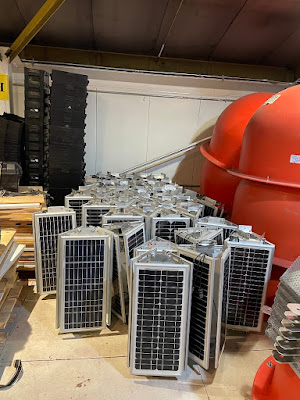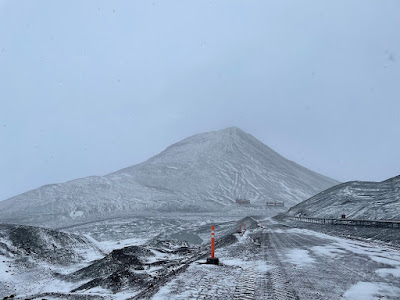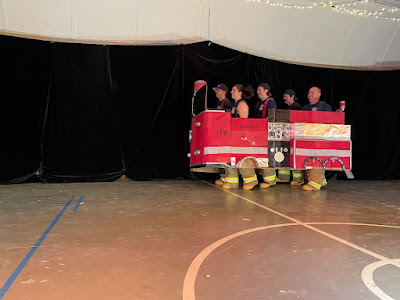Monday was a day for cargo. Plus the opening (and closing) night of the McMurdo Nutcracker!
One of the science teams that was able to make it out to WAIS a few weeks ago, the TIME group (I know, difficult acronym to use), arrived back in McMurdo this week. TIME = Thwaites Interdisciplinary Margin Evolution. They deployed equipment on the Thwaites Glacier 2 years ago, and were going back to collect the data and demobilize (remove) the stations this season. You may have heard of Thwaites Glacier in the news -- it's a rapidly melting glacier that could cause pretty significant sea-level rise if and when it collapses (which could be very soon).
The experiment deployed 14 seismic stations (with PASSCAL equipment!), plus several GPS and ApRES stations. Data from the seismic stations will help image the glacier, and get a better idea of the material properties of the ice. The GPS stations track how fast the glacier has been moving into the ocean.
ApRES stations use phase-sensitive radar to measure the thickness of the ice and the orientation of the ice crystals. This can help the group determine how fast the glacier is melting from underneath, as the thickness of the glacier decreases over time.
This is extremely important research, and one of the many reasons why I love my job at PASSCAL is that I get to interact with the scientists on all of these experiments. One of the scientists in those articles (Ted Scambos) is actually in Antarctica now, and I got to talk to him and listen to a lecture about his groups' experiment on Thwaites. I've been able to talk with another scientist (Erin Pettit) about an experiment her group is setting up in Greenland this summer (with PASSCAL equipment). I'm in a pretty unique position, and I'm so grateful to be able to interact and learn about the research that all of these groups are doing.
The TIME group had originally planned for a 60-day field season to dig out and demobilize 14 seismic stations that were buried several meters deep in the snow. With all the delays and cancellations this season, they were only able to make it out into the field for 10 days.
No one thought that they'd be able to dig out all the equipment and ship it back to McMurdo with such a reduced field season. But the TIME team got lucky with no bad weather days, and were able to dig out all the equipment (minus a few cables) with a truly heroic effort (and no rest days....). They were able to throw the equipment on pallets and it arrived back in McMurdo on the same flight as the team. Since the equipment is all PASSCAL, Avi and I will now take over and make sure the cargo is packed properly and shipped out.
On Monday, we tackled the solar panels. The carps (McMurdo speak for carpenters) built us these beautiful, sturdy boxes to hold 4 of our solar panel setups.
 |
| Beautiful red boxes for PASSCAL solar panel arrays. |
 |
| Each box holds 3 lampshades very nicely. |
The seismic stations for the TIME experiment each used one of our "lampshade" solar arrays. Lampshades are three 20W solar panels arranged vertically around a pole. Solar panels are vertical, and facing all directions, at our Antarctic sites because the sun goes around in a circle (simple, right?).
 |
| Lampshade (minus the pole) siting on the ground. |
We tested all of the panels with a multimeter to make sure they were still in good condition. We also had to melt the snow out of a few of them.
 |
| Lampshade completely filled with snow/ice. |
The Science Cargo group kindly used their loader to move the boxes to one of the buildings with PASSCAL storage. Then Avi and I hoisted the boxes up to the second floor.
 |
| Hoisting the boxes up! I wrapped the straps around and Avi worked the hoist from above. |
We found a nice home for the boxes upstairs.
 |
| Solar boxes fit perfectly! I only found the pallet jack after struggling for several min to push the boxes around.. |
And also realized that PASSCAL has dozens of lampshades already up there. If PASSCAL is anything, it's overly prepared with equipment.
 |
| Lampshades, lampshades, everywhere!!!!!!!! |
 |
| The Antenna Moose watches over EVEN MORE lampshades. |
While we were moving the lampshades around, I got to watch a helicopter with a slingload land. It was very cool -- the slingload is attached with a quick-release so the pilot can drop it on the ground before landing.
 |
| Helicopter with slingload! We'll be slingloading batteries up to Mt Erebus for an experiment next year. |
It snowed that afternoon! The McMurdo forecast predicted a "decent amount" of snow. After work, I bundled up in my big red and went on a snow walk.
 |
| Me in my big red! |
 |
| I felt like a warm, puffy, red marshmallow. Very cozy (except my nose). |
 |
| Ob hill in the snow. |
 |
| The wind was howling. You can see the snow blowing across the road. |
I warmed up after my snow walk and then went to the McMurdo Nutcracker! It was both the opening and closing night (only one showing!). And it was absolutely phenomenal. Two of the folks who work in the galley do ballet, and had organized this amazing performance. They all danced to the Nutcracker suite, but the scenes were McMurdo-themed. Featuring scenes of the janos (janitors), fuelies (people who work in Fuels), wasties (people who work in waste), firefighters (firefighters), and more!
 |
| One of the opening scenes showing the (turbulent) flight from Christchurch to McMurdo. |
 |
| Firefighters in an extremely detailed firetruck set piece. |
 |
| The whole cast at the end! |
The performers worked so hard on the show, and it was very evident. What a fantastic show!!
Comments